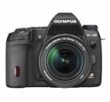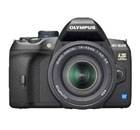Olympus E-30 vs. E-620 |
Page updated: March 2009 |
When you begin to compare the Olympus E-30 vs. the E-620, you quickly realize the following: these two cameras have quite a lot in common.
At quick glance, they appear virtually identical in terms of features and functionalities.
It's not until you dig a bit deeper - OK, a LOT deeper - that the differences begin to emerge.
And it might just be one of these small differences between the Olympus E-30 vs. the E-620 that makes one more appealing to you.
What's the Same
Before we dig into the minute differences between these two digital SLR cameras, let's do something easier first: review what they have in common.
Each camera has all of the following features:
- 12.3 megapixel sensor
- Stores photos on Compact Flash and xD memory cards
- ISO range from 100 to 3200
- 2.7 inch LCD that flips out from the camera body
- Dust control
- Built-in image stabilization
- Live view LCD
- Special "art filters" that can be applied to any image
- Compatible with all Olympus 4/3rds lenses
That covers the common ground, now let's dig into what sets these cameras apart.
What's Different
Size and Weight
| E-30 | E-620 | ||
|---|---|---|---|
| Dimensions (WxHxD) | inches | 5.6x4.3x2.9 | 5.1x3.7x2.4 |
| mm | 142x108x75 | 130x94x60 | |
| Weight | ounces | 27.2 | 16 |
| grams | 768 | 521 | |
The table above illustrates that the Olympus E-30 is a bit larger and heavier vs. the E-620.
Size and weight are most important to people who want to carry their digital SLR everywhere - this is especially true for travel photographers.
Having a smaller and lighter camera not only means that you can spend the day taking photos without feeling like you're carrying around a lead weight, but a smaller camera also draws less attention to itself.
Bottom Line: if you want an SLR that's small and light, the E-620 is the clear choice.
Autofocus Points
The more autofocus point a camera has, the better it is at locking on to subjects that aren't right in the middle of the viewfinder.
An 11-point autofocus like the one on the E-30 covers pretty much the entire viewfinder - no matter where your subject might be, there will be an autofocus point.
The E-620 reduces the number of points down to 7 - not a huge difference, but worth noting.
This just means that if you take a lot of photos of subjects that move around all the time, then you might get more in-focus shots with the E-30.
Bottom Line: if you take photos of off-center subjects that tend to move around a lot, then the E-30 is better.
Continuous Speed (Frames Per Second)
The E-30 has a slight edge over the E-620 when it comes to continuous shot speed.
Faster continuous shot rates are often better for action photographers who want to grab several frames in rapid succession.
Is there a huge difference between the 4 FPS on the E-620 and the 5 FPS on the E-30? Not really.
But if action photography is your passion, then you might find that the extra speed helps you to capture just the image you want.
Bottom Line: if you want to capture action in rapid bursts of images, then the E-30 is slightly better
Aspect Ratios
Both cameras allow you to select the aspect ratio of the images you capture - a unique feature not available on any other digital SLRs.
The main difference is that the E-620 only lets you choose one of 4 different aspect ratios while the E-30 has 9.
- The four E-620 aspect ratios are 4:3, 16:9, 3:2 and 6:6
- The nine E-30 aspect ratios are 4:3, 16:9, 3:2, 6:6, 5:4, 7:6, 6:5, 7:5 and 3:4
The aspect ratio control allows you to match the dimensions of your image to standard print sizes.
For example, if you're taking photos that you want to make into 8x10 prints, the you can select the 5:4 aspect ratio on the E-30 - but there's no exact match on the E-620 (the closest is 4:3).
For 5x7 prints, you can select the 7:5 ratio on the E-30 - again, there's not exact ratio on the E-620 so you will have to crop the 4:3 image a bit.
The only issue with this level of aspect ratio control is that you actually have to know ahead of time what size print you might want to make.
I tend to shoot first and worry about print sizes later (once I've got an image that actually worthy of enlargement) but if you can plan ahead and know for sure that you'll be making enlarged prints, then selecting the matching aspect ratio will prevent you from having to crop your photo before you print.
Bottom Line: if you anticipate printing at a variety of sizes including 4x6, 5x7 and 8x10 AND feel that you'll know ahead of time what print size you'll use, then the E-30 has more matching ratios.
Multiple Exposures
Like with aspect ratio, both cameras let you take multiple exposures (multiple shots layered into one image).
There's not a huge difference here between the Olympus E-30 vs. the E-620, but it's there: the E-620 can only create a multiple exposure based on two photos, while the E-30 can use four.
Bottom Line: if you love multiple exposures, then the E-30 has more range.
Flash
When it comes to flash, the E-30 has more versatility than the E-620.
The flash sync speed on the E-30 is faster: 1/250th of a second vs. 1/180 on the E-620.
Faster flash sync speeds provide you with more ability to control the brightness of the background when you're using any type of flash (built-in or external).
If you do want to use more powerful studio flashes, then one way to trigger them is by connecting a cord to a PC sync port.
The E-30 has such a port, the E-620 does not.
Bottom Line: if you want to use flash, then the E-30 is better.
Battery
The E-620 uses a lower capacity battery than the E-30.
This just means that the E-620 battery won't hold a charge for quite as long as the E-30's.
While this might be problematic for photographers who take hundreds of shots per day, there's a pretty simple solution: buy an extra battery.
With the extra battery on hand, you can swap out the charged one for the dead one and keep right on shooting.
Bottom Line: if you want longer battery life, then get the E-30.
Compare Prices
| CAMERA | RELEASE | SUMMARY | AVG. COST | COMPARE |
|---|---|---|---|---|
|
Olympus E-30
 |
December 2008 | The E-30 has a faster burst rate, more AF points, more aspect ratios, more multiple exposures and a longer battery life than the E-620. | $1,300 USD | |
|
Olympus E-620
 |
May 2009 | While the E-620 doesn't have all the features of the E-30 it's smaller and lighter and it costs significantly less. | $700 USD |
Related Links
| Digital SLR Home | Olympus Digital SLRs |





